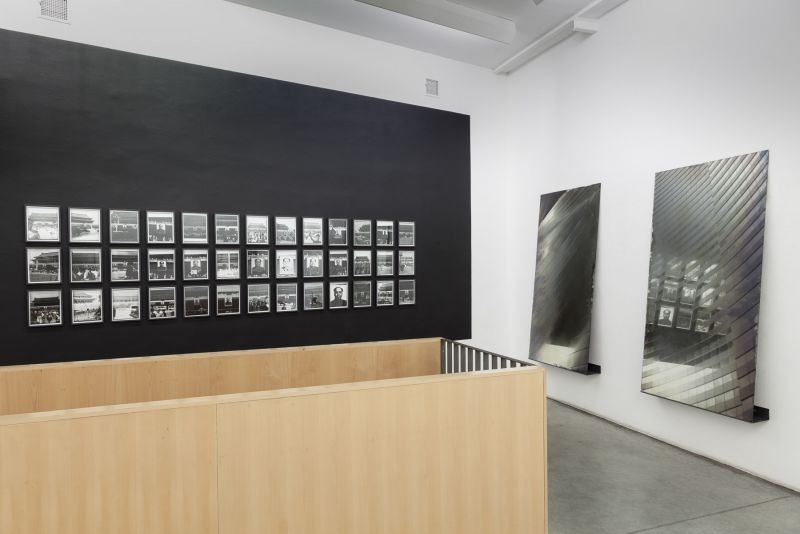Andreas Duscha
White Collar
18 Oct - 17 Nov 2018
ANDREAS DUSCHA
White Collar
18 October - 17 November 2018
Andreas Duscha (*1976 in Heidenheim a. d. Brenz, Germany), who is known as a critical and nimble manipulator of stories and who has a predilection for employing "outdated" photographic techniques, conceives, in his current exhibition, a course between art historical quotation and surveillance mania. The eponymous "White Collar" pays tribute to the American criminal series of the same name, whose protagonist is a con-man of the first order. Yves Klein was also occasionally described in this fashion by his critics, since he created his "first infinite and immaterial painting lying on the beach at Nice, in that he signed the blue Mediterranean sky and declared it to be his first and greatest 'Monochrome'."
It is in this spirit that Andreas Duscha dedicates the cyanotypes to Yves Klein. The first room impresses with its interpretation of works by Klein, which Duscha applies to canvas with the aid of the old-fashioned printing process – International Klein Blue on Prussian blue, so to speak. They are subtle superimpositions; only the contours suggest the hommage to Yves Klein. With the choice of an extremely thin canvas instead of the light-sensitive photographic paper, Andreas Duscha develops the medium a step further. It is an attempt, as Duscha says – and not without self-irony – to come as close to painting as possible. A reference to Yves Klein, then, but also a scrutiny of the mystification of an artistic personality.
From abstraction in the visual arts, Duscha leads the viewer to the abstraction of time: nine clocks, arranged in diptych form and which have stopped, bear witness to the vanishing of the display of time in public space. Its necessity has become largely obsolete due to the digitalisation of the 21st century, so that the pre-programmed inner clock of the metropolitan citizen starts to falter. Andreas Duscha's grain of sand, therefore, in the well-lubricated mechanism of capitalism, whose slogan "Time is Money" is elegantly displayed. It requires at least some level of attention to notice that a clock has stopped. A stopped clock only displays the correct time twice a day, and then only for a minute: these are the imaging moments.
The manipulation of time is also the theme of the last room of the exhibition: by using pinhole cameras, Andreas Duscha creates dense images of sites in the public domain which are under constant video surveillance. Due to the long exposure time, the content of the photographs is dissolved beyond recognition, and the print becomes a phantom of the original scene. The works, framed behind glass, are compressions of hours of material which normally would not receive any additional application. Nevertheless, the constantly observed people – that is, all of us in the public space – are made to feel a great deal of unease. (Andrea Kopranovic, 2018)
A special edition bottle, designed by Andreas Duscha for Wodka Linia, will appear at the exhibition (Artist Edition No2).
White Collar
18 October - 17 November 2018
Andreas Duscha (*1976 in Heidenheim a. d. Brenz, Germany), who is known as a critical and nimble manipulator of stories and who has a predilection for employing "outdated" photographic techniques, conceives, in his current exhibition, a course between art historical quotation and surveillance mania. The eponymous "White Collar" pays tribute to the American criminal series of the same name, whose protagonist is a con-man of the first order. Yves Klein was also occasionally described in this fashion by his critics, since he created his "first infinite and immaterial painting lying on the beach at Nice, in that he signed the blue Mediterranean sky and declared it to be his first and greatest 'Monochrome'."
It is in this spirit that Andreas Duscha dedicates the cyanotypes to Yves Klein. The first room impresses with its interpretation of works by Klein, which Duscha applies to canvas with the aid of the old-fashioned printing process – International Klein Blue on Prussian blue, so to speak. They are subtle superimpositions; only the contours suggest the hommage to Yves Klein. With the choice of an extremely thin canvas instead of the light-sensitive photographic paper, Andreas Duscha develops the medium a step further. It is an attempt, as Duscha says – and not without self-irony – to come as close to painting as possible. A reference to Yves Klein, then, but also a scrutiny of the mystification of an artistic personality.
From abstraction in the visual arts, Duscha leads the viewer to the abstraction of time: nine clocks, arranged in diptych form and which have stopped, bear witness to the vanishing of the display of time in public space. Its necessity has become largely obsolete due to the digitalisation of the 21st century, so that the pre-programmed inner clock of the metropolitan citizen starts to falter. Andreas Duscha's grain of sand, therefore, in the well-lubricated mechanism of capitalism, whose slogan "Time is Money" is elegantly displayed. It requires at least some level of attention to notice that a clock has stopped. A stopped clock only displays the correct time twice a day, and then only for a minute: these are the imaging moments.
The manipulation of time is also the theme of the last room of the exhibition: by using pinhole cameras, Andreas Duscha creates dense images of sites in the public domain which are under constant video surveillance. Due to the long exposure time, the content of the photographs is dissolved beyond recognition, and the print becomes a phantom of the original scene. The works, framed behind glass, are compressions of hours of material which normally would not receive any additional application. Nevertheless, the constantly observed people – that is, all of us in the public space – are made to feel a great deal of unease. (Andrea Kopranovic, 2018)
A special edition bottle, designed by Andreas Duscha for Wodka Linia, will appear at the exhibition (Artist Edition No2).

